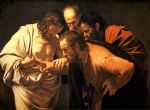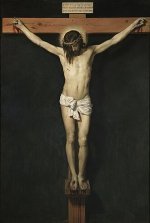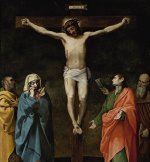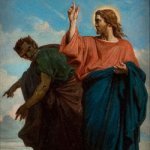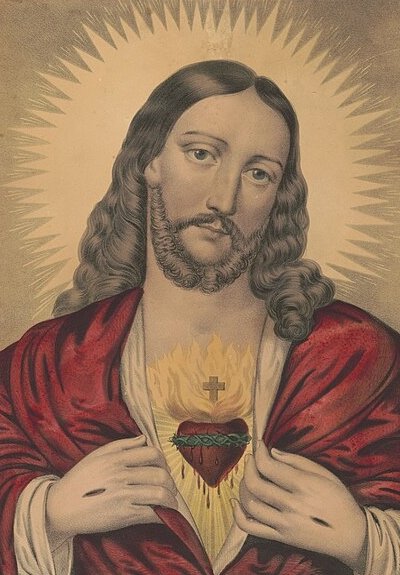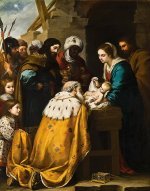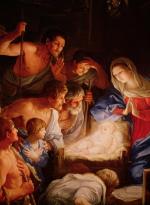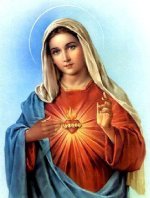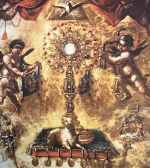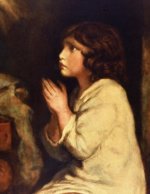CHRIST'S WOUNDS AND THE ORIGINAL DOUBTING THOMAS
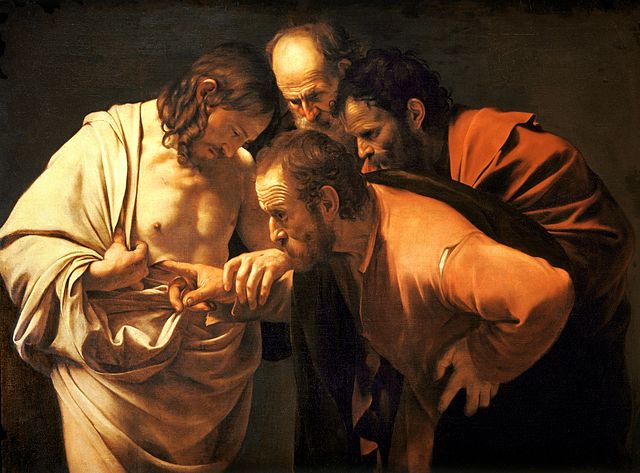
THE FIVE FIRST SATURDAYS IS A DEVOTION NEEDED NOW MORE THAN EVER! FIND OUT MORE HERE
THE SAINT MICHAEL PRAYER AND THE ROSARY
ARE ALSO POWERFUL PRAYERS TO HELP US THROUGH THESE VERY TURBULENT TIMES!
FATHER CHAD RIPPERGER HAS RELEASED A PRAYER FOR THE CONSECRATION OF THOSE GOVERNING TO THE BLESSED VIRGIN MARY
DETAILS (AND THE PRAYER ITSELF) HERE WITH AN UPDATED PRAYER TO OUR LADY HERE
HIGHLY RECOMMENDED! DELIVERANCE PRAYERS,
A BOOK FROM SENSUS TRADITIONIS PRESS
(A GREAT PUBLISHER HELPING US FIGHT OUR MANY SPIRITUAL BATTLES NOWADAYS)!
CHECK OUT OUR PODCAST PAGE AND OUR YOUTUBE CHANNEL FOR INSPIRING CONTENT
As we read accounts of Christ’s Resurrection in the Easter season, there's a great line in the well known prayer Anima Christi that resonates with the story of our first Doubting Thomas, St. Thomas the Apostle, as told in John's Gospel Chapter 20, verses 24-29. Let’s look at that great prayer first. It’s a great prayer to say after receiving Communion!
Soul of Christ, sanctify me
Blood of Christ, save me
Water from the side of Christ, wash me
Passion of Christ, strengthen me
Oh good Jesus, hear me,
Within Thy Wounds hide me. (Emphasis added)
Suffer me not to be separated from Thee.
From the malignant enemy defend me,
At the hour of my death, call me,
And bid me come to Thee.
That with Thy saints, I may praise Thee,
Forever and ever.
In dealing with our own sufferings and tribulations, do we wish to offer them up to Christ crucified in His five wounds still still present after His resurrection for His protection, strength and expiation for sins, figuratively speaking, that we may be healed by those wounds, as St. Peter would note in his first letter (1Pet 2:24) echoing the prophet Isaiah’ words to the same effect (Is 53:5)?
Or would we rather rub salt in them by turning away from Our Lord, in anger for His allowing us to experience pain or the loss of a loved one, perhaps, then engaging in antisocial behavior with a perennially sour disposition?
As we focus on Christ’s resurrection after Easter, the story of the original doubting Thomas, one of the 12 Apostles, can fortify our belief that our Lord really did “rise from the dead” to conquer death so that we might have Eternal LIfe!
You may recall Jesus’ response to Thomas’ claim that the apostle needed to actually touch the wounds from our Lord’s crucifixion to believe in His resurrection. Jesus had the doubting apostle do so, after which Thomas exclaimed “My Lord and my God!”
And Jesus’ memorable response was "You have believed because you have seen me. Blessed are those who have not seen and yet believe” (John 20:29). In this case, Christ’s wounds served not only as a testimony to the veracity of the Paschal mystery but also as a reminder of His love for us and His hatred for sin as shown by His Crucifixion.
The original Doubting Thomas, in some ways, did us all a favor with his earlier denial of Jesus' Resurrection. From this Gospel passage Jesus reminds us, not for the first time, that he was not a ghost or a hallucination, but a real walking breathing human being (although one with a Divine nature as the Son of God as well as a human nature) whom you could touch and even poke at His wounds!
And in the context of offering up our own wounds, hiding in our Lord’s symbolically, as it were, we can thanks Saint Thomas’ for giving us all this valuable lesson. Meditating on the wounds Jesus sustained into His resurrection can reinforce our belief in His being not just some illusory “revolutionary” or just some prophet executed by the Romans, but rather as the Son of God as the 2nd Person of the Triune Majesty. As we say every Easter “Resurrexit sic ut dixit” (which is Latin for “He is risen as He said.”)
The Resurrection accounts are fascinating indeed! The apostles and disciples must have felt a mixture of mourning and, in the case of the apostles, a bit of guilt and shame in the waning hours of that first Good Friday.
Despite all their bravado at the Last Supper, pledging unwavering loyalty to our Lord even at the risk of their lives, they had fled in terror when they saw a large crowd armed with swords and clubs from the chief priests, the scribes, the elders along with some Roman soldiers, arresting Jesus and taking Him away from Gethsemane. In addition they had been out of sight, except for Saint John, during our Lord’s Passion and Death as well.
And suddenly only two days later, He not only appeared before them, seemingly out of nowhere but, after showing them those very wounds in His hands and His side that He suffered during His crucifixion, He ate a piece of baked fish before them!
Imagine how the Apostles’ sense of incredulity and shame gave way to wonder and even joy as our risen Lord ate that fish right in front of them. Apparitions don't eat right? A ghost or a mirage doesn't ask for food! Nor does he have flesh and bones as Jesus pointed out (Luke 24:39)!
And yet Thomas was not there that day. It would be eight days later that Jesus would prove he’d conquered death with His wounds from His crucifixion. So Jesus in his own special way enlightened not only doubting Thomas but all of us as well!
But those sacred wounds in His side, his hands, and his feet can remind us, much as we do looking at and praying before a Crucifix, of the debt our Lord paid to his Heavenly Father on our behalf for our salvation!
This would by no means be the only appearance of our Risen Lord! Indeed, we read in St. Luke’s account in the beginning of the book of Acts that “To them [the apostles] he presented himself alive after his passion by many proofs, appearing to them during forty days, and speaking of the kingdom of God (Acts 1:3).”
Indeed, the Ignatius Study Bible lists some ten scriptural references to Jesus appearing from 1 Apostle (in this case Saint Peter) to, as Saint Paul put it “more than 500 brethren at once”(1 Cor 15:6) many of whom were still alive at the time he wrote this first letter to the Corinthians, around 57 AD!
These distinct accounts give us more than enough evidence that, as St. Peter would write about having witnessed our Lord’s Transfiguration in His earthly ministry about Jesus’ meeting Moses, Elijah and God the Father on Mount Tabor (which is chronicled in 3 Gospels as well!) that “we did not follow cleverly devised myths when we made known to you the power and coming of our Lord Jesus Christ, but we were eyewitnesses of his majesty” (2 Pet 1:16).
And as our Lord Himself said to the disciples on the Road to Emmaus, as He had told disciples on several occasions in His Earthly ministry concerning His then upcoming Passion, Death and Resurrection, (Luke 24: 26) Was it not necessary that the Christ should suffer these things and enter into his glory?"
We can indeed be grateful that Christ allowed His wounds from His Crucifixion to eliminate not only all of Thomas’ doubts but hopefully ours as well! We can also thank St. John for having recorded this event in His Gospel (John 20:24-29).
And as another St. John, St. John Chrysostom, the 4th century Bishop of Constantinople declared in one of his homilies “If any one then says ‘Would that I had lived in those times, and seen Christ doing miracles!” let him reflect, Blessed are they that have not seen and yet have believed”.
In so many ways, such as the over 100 Eucharistic Miracles where Our Lord’s blood has emanated from hosts; and the numerous accounts in church approved private revelations in which our Lord has appeared to mystics and saints, we who have not seen Him may indeed believe in Him as “God from God, light from light, true God from true God” as we say in the Nicene Creed.
And as such that, as St. John the Evangelist says in His Gospel Ch.20:31 “that you may believe that Jesus is the Christ, the Son of God, and that believing you may have life in his name.”
FROM OUR BOOK AND GIFT STORE
OR CAFE PRESS STORE!
Return from Christ and Thomas
to Prayer Blog Page



